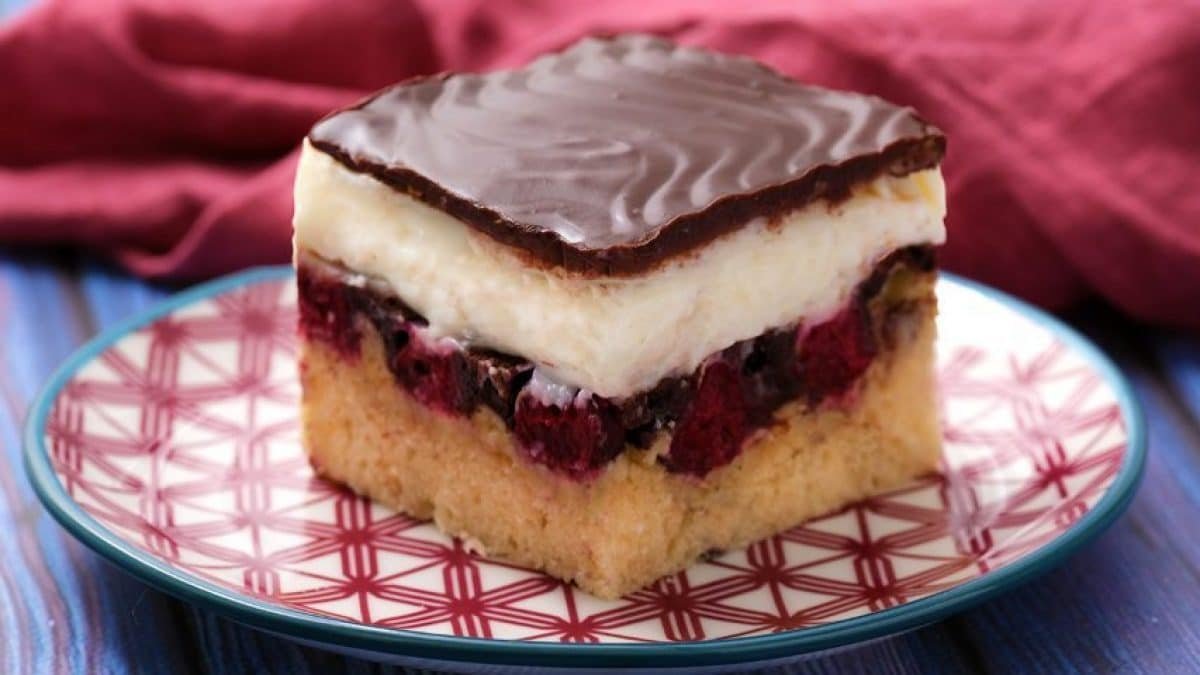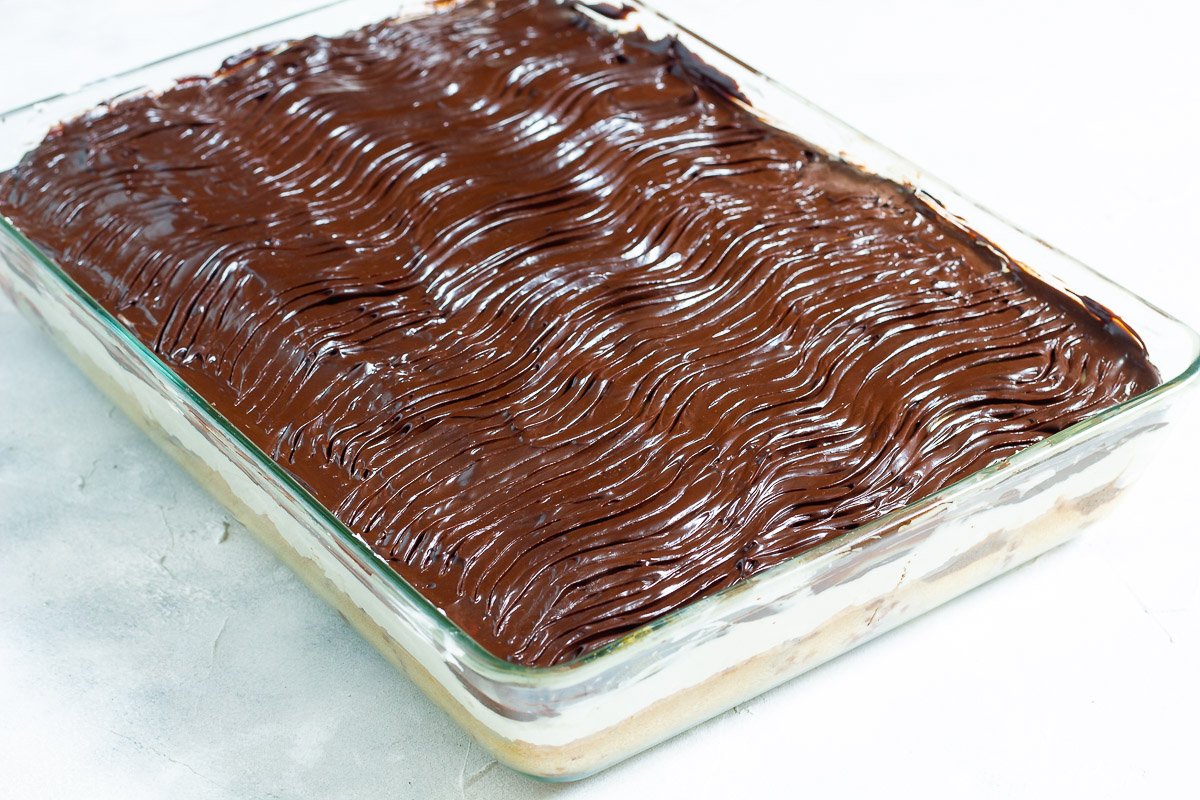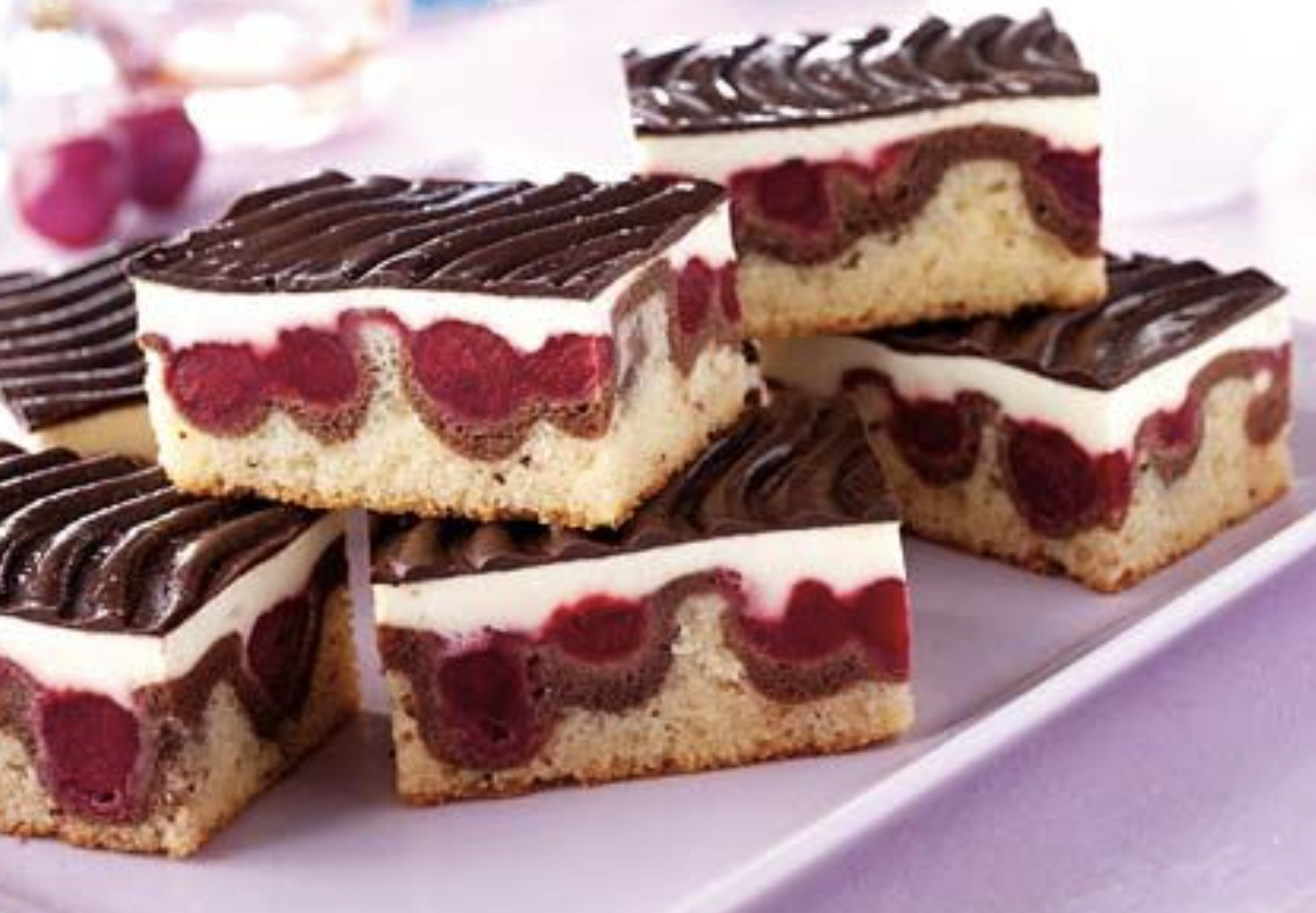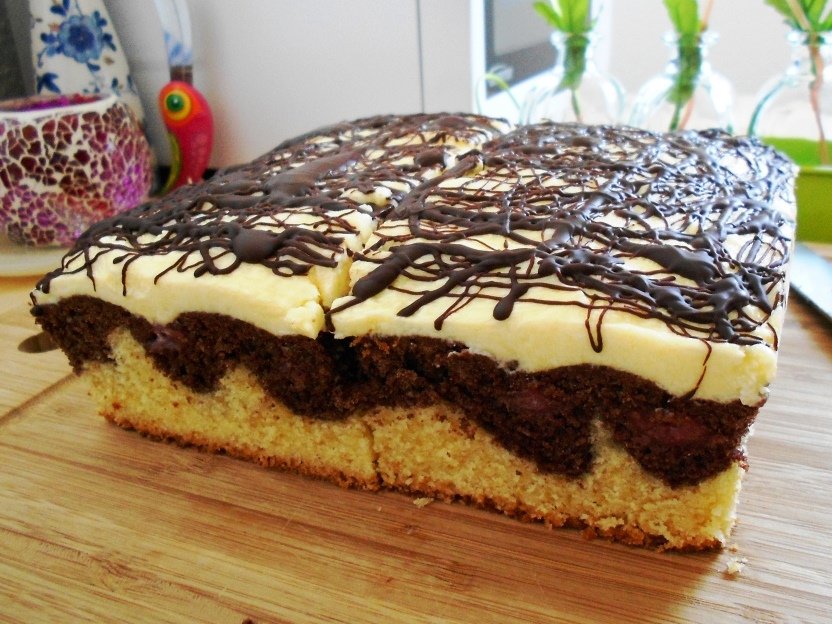THIS MONTH’S CULTURAL BAKE IS WRITTEN BY:
SPRINKLER CASSI, PORTLAND METRO CHAPTER
GUTEN TAG (HELLO), FELLOW SPRINKLERS!
Today we are visiting Germany and its rich tradition of baking!
Germans love cake and enjoy the custom of having Kaffee und Kuchen (coffee and cake) every Sunday afternoon, usually with a fresh, home-baked cake. For those pressed for time, a piece of cake from the bakery will do just as well.
Here, I want to introduce you to a German favorite called Donauwelle (dough-no-vell-eh). The name describes the wave like pattern the cake has when you cut into it – like the river Danube (Donau), one of the biggest rivers in Europe.
Donauwelle is a classic sheet cake (Blechkuchen (bleh-cookin)) which makes it a good pick for a party or birthday since it will feed a lot of people. It has several layers comprising of light and dark batter, cherries, German Buttercream and chocolate glaze. It is not difficult to make, but it does require some time as the cake and the buttercream need to be completely cool before you can assemble the cake.
Source: Google Images
FUN FACTS
Similar to the US, in Germany, birthdays are celebrated with cake, presents, family and friends. The most notable difference is that in Germany you would (almost) never celebrate your birthday before the actual day. When asked why, most Germans will simply say it is just not done, or that it is bad luck. The idea behind that superstition is that you are challenging fate/god/the universe by celebrating something that has not actually happened yet. The same is true for wishing someone a Happy Birthday. You simply do not congratulate someone before the actual day. If you want to wish someone a Happy Birthday in German – and only on their actual birthday 😉) – you would say Alles Gute zum Geburtstag [alice-goot-uh-zum-guh-buhwts-tahg] or Herzlichen Glückwunsch zum Geburtstag!
If a child’s birthday is on a weekday, then it is quite common to celebrate with just their closest family (parents, siblings, grandparents) on the actual birthday, and then have a party with friends the weekend after. Turning 18 is probably the biggest milestone in the life of a young German. That is when you are officially an adult and are allowed to vote, drink alcohol, sign contracts, and drive a car (that’s right, no driver’s license at 16!).
Topfschlagen - Upside down pot with a prize inside Source: Internet!
Normally, parents will not attend the birthday parties their children and the kids are mostly left to their own devices to play games and have fun together. One of my personal favorite childhood memories is the games that we would play at birthday parties – Topfschlagen or Schokoladen-Wettessen, for example.
Topfschlagen [topf-shlahgg-in] translates into “hit the pot” – an upside down pot with a little toy or candy underneath is hidden in the room, and then a child with a blind fold crawls around the floor with a wooden spoon in their hand, hitting the ground in front of them trying to find the pot. The other kids will guide the blindfolded kid by shouting “warmer” or “colder” as the kid moves around the room. Check out this video here for a more in-depth explanation!
Schokoladen-Wettessen - Funny race to eat a bar of chocolate Source: Internet!
Schokoladen-Wettessen [cho-co-la-den vet-tes-sen] – is a funny race to eat a bar of chocolate. The children sit all around a table with a bar of chocolate in the middle and pass around a die. The first kid to roll a six has to put on a hat, mittens, and a scarf and then try to eat the chocolate bar with a knife and a fork. Once another kid rolls a six, the first kid takes off all the clothes and the second puts them on and then tries to eat the chocolate with a fork and knife. Since it is really hard to eat a chocolate bar like this, there is plenty left over at the end of the game to share with everyone. I can highly recommend you try playing them at your next party!
Sprinkler Cassi’s Birthday in 1988!!
AUF WIEDERSEHEN (GOODBYE)!
DIVERSITY IS AWESOME!
For Goodness Cakes staff who identify as either part or full German :) 🇩🇪
Donauwelle Cake Demo by Sprinkler Cassi 🥳🎂💖
Donauwelle (Snow White Cake)
** Please remember to mask up when baking cakes for our Sprinkly Kiddos and Young Adults **
Equipment:
18” by 12” deep baking sheet
Hand mixer or stand mixer
Cake:
3 ½ cups (400 g) All-purpose flour
1 ½ cups (300 g) Sugar
2 Tsps. Vanilla Extract
4 ½ Sticks (500 g) Butter (room temperature)
5 Eggs (room temperature)
4 Tsps. (15 g) Baking Powder
½ Tsp Salt
⅓ cup plus 1 Tbsp. (100 ml) Milk (room temperature)
1 oz. (30 g) Unsweetened cocoa powder (Dutch processed if you have)
¼ cup (50 ml) Milk
24 oz. (700 g) Drained Pitted Sour Cherries (e.g. Morello Cherries)*
Buttercream:
1 Pack (40 g) Dr. Oetker’s Vanilla Pudding Powder (click here for example, or make your own )
½ cup (100 g) Sugar, divided
1 ½ cups plus 3 Tbsps. (400 ml) Milk
2 sticks plus 2 Tbsps. (250 g) Butter (room temperature)
2 Tsps. Vanilla Extract
Chocolate Glaze:
10 oz. (300 g) Dark or semi-sweet chocolate
2 ½ Tbsps. (20 g) Coconut oil
*You could also use fresh sour cherries, but they have a very short season, so it is easiest to find them in a jar. Make sure you get sour or tart cherries either in water or their own juice; you do not want cherries is syrup or Amarena cherries (which often come up in an internet search) – the cherries are supposed to provide a tart contrast to the sweet cake. Using cherries sweetened, preserved like Amarena or Maraschino cherries will change how the cake taste (depending on your taste you may still like it!).
Directions
Preheat the oven to 350 ° F.
Butter the baking sheet and line it with parchment paper and butter the parchment paper.
Start the batter by creaming together the butter and sugar. You want to whip it with a hand mixer or stand mixer until the butter looks markedly lighter and fluffier – 3 to 5 minutes.
(If you forgot to take the butter out of the fridge, cut the butter into small cubes and spread them out on a large plate. By the time you have gathered and measured all the other ingredients, the cubes should be warm enough to cream – about 15 to 20 minutes).Slowly add the room temperature eggs. Make sure to incorporate each egg well before adding the next. It is important that the eggs are room temperature otherwise they will not mix well with the creamed butter.
(If you forgot to take out the eggs well ahead of time, warm them up by placing them in a large bowl with lots of warm water for about 10 to 15 minutes. That is not a perfect solution, but it will significantly lessen the temperature difference between the ingredients, which is the most important part).Add the vanilla extract and mix in.
Keep mixing until the butter-egg mixture starts to have a pudding-like consistency, and then it is time to add the dry ingredients and milk. Mix the flour, baking powder and salt in a separate bowl so that you can add them all together and thereby keep the time to incorporate everything as short as possible. The same goes for the milk. Don’t overwork the batter; just keep mixing until no streaks remain.
Pour half of the batter into the prepared baking sheet and smooth with an offset spatula or whatever tool works for you. Some people like to use a cake/bench scraper.
Add the cocoa powder and milk to the remaining batter and mix until incorporated, then pour it on top of the white batter and spread evenly. Make sure to not pour all the batter into the same spot, otherwise it will be difficult to spread. You could also spoon it over the like batter in blobs and then spread it out. This can be a bit tricky, but do not worry too much about making it neat; it will taste just as good when it is a bit messy.
Scatter the well-drained cherries on top of the dark batter and very gently press them in (that will create the typical wave pattern of the cake).
Bake for 25 to 30 minutes (every oven is different, so it might take 35 or 40 minutes for the cake to be done, but I would start checking around the 25 minute mark). The cake is done when you can insert a toothpick in the middle of the cake and it comes out clean. Place the cake on a cooling rack and let cool completely. If the cake is still warm, when you put the buttercream on it will run off.
While the cake cools, make the vanilla pudding. In a small bowl, mix the pudding powder with 2 tablespoons of sugar and 6 tablespoons of milk.
In a pot, heat up the remaining milk and sugar until it comes to a simmer. Off heat, add in the pudding powder mix. Return pot to burner. While stirring constantly, bring to a boil over medium-high heat. Cook until the mixture thickens and looks like, you guessed it, pudding. It should cook for about 1 minute after it has returned to boiling.
After the pudding has thickened, pour it into a bowl and cover it with plastic film – press it directly onto the pudding, this will ensure that no skin will form. Let it cool to room temperature.
If you are making the cake all in one day, don’t refrigerate the pudding; it needs to be room temperature to mix well with the butter. If you choose to make the buttercream the next day, refrigerate the pudding and then let it sit out for 2 to 4 hours so it is room temperature before using it for the buttercream.Once both the cake and the pudding are room temperature, it is time to make the buttercream. Whip the butter until it looks almost white, that should take about 3 to 5 minutes. Add the vanilla towards the end. With the mixer running, start adding the room temperature pudding.
Once it is all combined, it is time to spread it over the cake. Spread the buttercream evenly over the cake with an offset spatula and then refrigerate it for about 30 minutes.While the cake is in the fridge, make the glaze. Melt the chocolate in a double boiler (fill a pot with about one inch of water and bring to a boil, then lower the temperature to keep it hot but not boiling. You do not want the hot water to touch the bowl.)
Set a bowl on top of the pot and add the chocolate and the oil. Gently warm the chocolate – you do not want the chocolate to get very hot, just melted so you can pour it. If it is too hot when you pour it on, it will melt the buttercream. (Yikes!) If pouring feels too precarious, you can try using a ladle to cover the entire cake. Smooth top with an offset spatula.Refrigerate the cake for about an hour to set the chocolate glaze. Run a knife under hot water before you cut the cake, that way the glaze will not crack when you cut it.
Guten Appetit!
DANKE!
Three cherry-filled cheers for Sprinkler Cassi 🍒🍫🎂 who delivered us this wonder German Cultural Bake and the recipe to go with! What wonderful ways to celebrate a birthday (fun games and no parents in the rooooom!) 😂
If you’re interested in writing for our Cultural Bake series to represent your culture, please fill out this form below!
WRITE FOR OUR CULTURAL BAKES SERIES!
We’ll get back to you in about a week, but in the mean time, we hope you get to enjoy this oh-so-chocolately delicious Snow White cake!
Happy Baking Sprinklers! 🎂=💖











